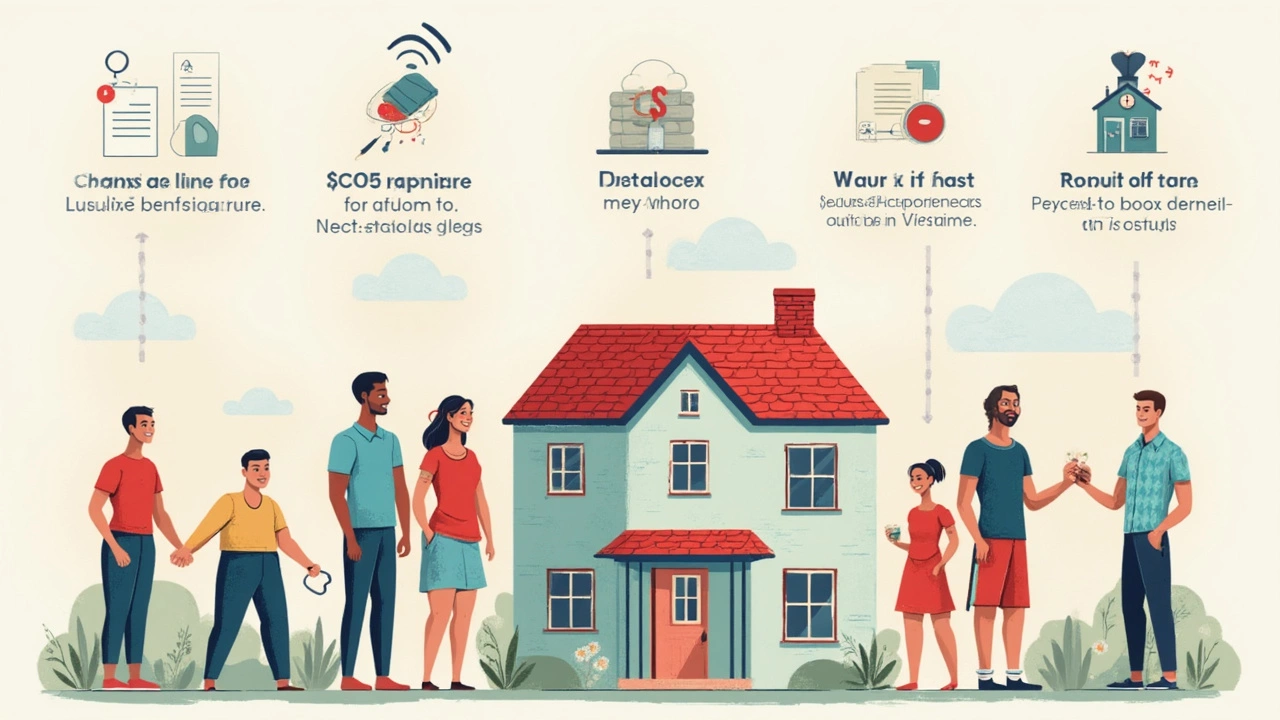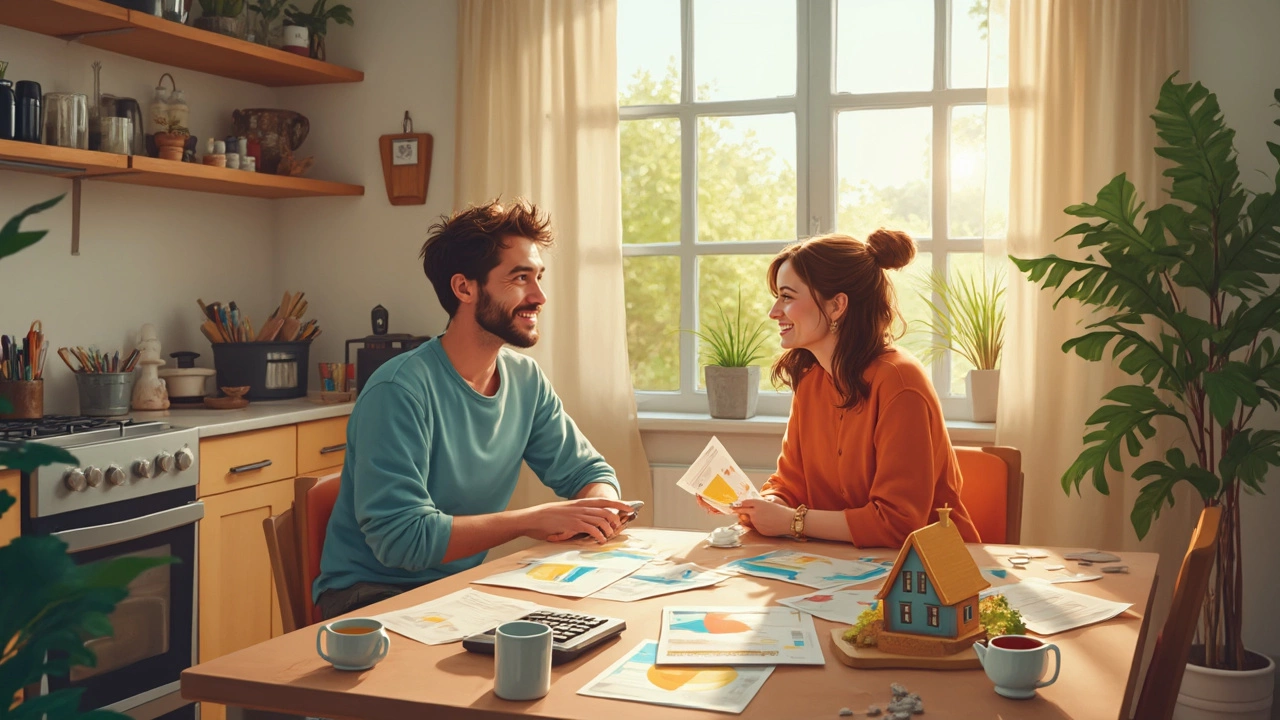Confused by how much of your home you actually own in a shared ownership scheme? You're so not alone. The fact is, most of us have stared at share percentages and monthly calculators, wondering if we're actually getting a fair deal.
Here's what you need to know straight away: in shared ownership, you're buying a chunk of the property—sometimes as low as 25%, sometimes as high as 75%. The rest? You pay rent on that bit to a housing association or similar group. So, you aren't just paying one bill—you've got both a mortgage and rent rolled into your monthly costs. That percentage you buy isn’t just a number—it decides how much you pay, how much equity you build, and what you can sell later.
When you see a place advertised as '50% shared ownership', half belongs to you. Buy a bigger share, pay less in rent, but your mortgage is higher (trust me, I did the math on this after sleepless nights with Nolan crying). Small tip: even a tiny bump from 50% to 55% ownership can make a difference to your monthly outgoings in the long run. Getting this split right up front saves headaches and cash down the road.
- What Is Shared Ownership and Why It Matters
- Breaking Down the Share Calculation
- How Your Share Impacts Monthly Costs
- Common Mistakes and Smart Tips
What Is Shared Ownership and Why It Matters
Shared ownership is a way to buy a home if you can’t afford the full price up front. It’s a legit government scheme, not some new trend. You buy a share of a property—usually between 25% and 75%—and pay rent on the part you don’t own. That rent usually goes to a housing association. People like it because it’s way more doable than scraping together a massive deposit for 100% ownership. Plus, mortgage repayments are based ONLY on your share. That’s why shared ownership gets people with limited savings onto the property ladder every year.
Here’s what that looks like in numbers:
| Property Value | Your Share (50%) | Deposit (5% of Share) | Monthly Rent (on 50%) |
|---|---|---|---|
| £300,000 | £150,000 | £7,500 | ~£343 |
So, if the full property price is £300,000 and you buy a 50% share, your mortgage only covers £150,000. If you put down a 5% deposit, that’s just £7,500, not £15,000. The rent you pay on the other half is much lower than market rent—usually around 2.75% of the unsold share per year. And you aren’t stuck: you can buy more shares later (this is called “staircasing”). Some folks start low and buy up to 100% when they can, which brings rent to zero.
Why does shared ownership matter? It helps people, especially first-time buyers, get a foot in the door when full ownership feels impossible. And with over 81,000 shared ownership homes bought in England from 2016 to 2023, it’s definitely working. If you want to avoid years of renting and build equity sooner, this might be your best shot. The share ownership piece is all about getting started without waiting forever to save for a huge deposit.
Breaking Down the Share Calculation
So, how do you actually figure out what slice of your home belongs to you? It's much simpler than it looks (but if you’re like me, you’ll still want a calculator handy).
Here's the deal: first, you look at the share ownership percentage you’re buying from the total property value. Let's say the flat is worth £320,000 and you’re buying 40%. You just multiply: £320,000 x 0.40. That means you own £128,000’s worth right from the start. The other 60%? That’s the part you pay rent on.
Breaking it down step-by-step:
- Get the full market value of the property you’re interested in—usually, the seller or housing association will list this up front.
- Punch in the percentage share you want or can afford (most schemes require you to buy between 25% and 75%).
- Multiply the market value by your chosen share as a decimal. For example, 35% is 0.35.
- That number is the value you need a mortgage (or savings) for. The difference between the full price and your share? That’s what you’ll pay rent on.
Want to see the numbers in action? If you go for a 50% share in a £250,000 house, 50% of £250,000 is £125,000. The other £125,000 is the bit you rent—monthly rent rates on this part typically range from 2.75% to 3% per year, so your monthly rent would be somewhere between £286–£313 (the housing provider always gives you a breakdown before you sign anything).
And don’t forget all the extra bits: you’ll usually pay service charges and ground rent on top, even if you only own a quarter of the place. Every provider should give you the detailed numbers—if they don’t, ask for them.
One more tip—check if you’re allowed to “staircase” (buy more shares later). Some people start small and then buy more as they can afford it, which can be way less stressful, especially if kid-related emergencies love to pop up when you're planning big moves.

How Your Share Impacts Monthly Costs
This bit often trips people up: the percentage of the home you buy directly drives how much you pay every month. The bigger the share you buy, the more you’ll pay on your mortgage—but the less rent you’ll fork out to the housing association. It’s a balancing act, and what’s best for you depends on your budget, deposit, and long-term plans.
Here’s how it breaks down:
- Mortgage repayments cover only the share you own. If you buy 40% of a home valued at £200,000, your mortgage is on £80,000 (not the full price).
- The rent you pay goes to the housing association for the portion you don’t own—in this example, the other 60%. Rent is usually set at around 2.75% of the unsold share’s value per year, though this can vary a little by provider and year.
Let’s do some real math. Imagine you buy 30% of a £300,000 flat. Your share is £90,000:
- You get a mortgage for £90,000.
- The other 70%, or £210,000, is still owned by the housing association.
- If the annual rent rate is 2.75%, you’ll pay £210,000 x 2.75% = £5,775 a year, which is about £481 a month in rent (before service charges or other fees).
Don’t forget to budget for service charges and maintenance on top. Even if you only own a small share, you’re usually on the hook for 100% of these costs. That’s just how shared ownership rules are set up.
Here’s a quick tip: If you can stretch to a bigger share upfront—even going from 25% to 35%—you’ll usually save money over time, because mortgage interest rates are often lower than the rent percentage. Over the years, that adds up. And as you "staircase" (buy more shares), future rent bills keep shrinking.
Keep an eye on rent reviews too—they usually increase each year, unlike a fixed-rate mortgage. That’s extra motivation to grab more equity if you can manage it. The main thing? The share split defines your monthly costs down to the penny, so use a calculator before you sign anything!
Common Mistakes and Smart Tips
It’s way too easy to get tripped up when figuring out your share in a shared ownership home. The biggest mistake I see? People mix up how much of the property they own versus their total monthly costs. Just because you buy a 40% share doesn’t mean you’re done—there’s still rent on the rest, not to mention service charges that sneak up on you.
Watch out for these common slip-ups:
- Share ownership is not the same as your mortgage. Only your portion is covered by the mortgage—so don’t let the percentage fool you into thinking you own the whole place.
- Many forget to check how rent on the unsold share increases over time. Most housing associations bump up the rent every April by a set percentage above inflation. That tiny increase today can mean a much higher bill later down the line.
- Don’t ignore the details in your lease. Some have strict rules about selling or 'staircasing' (buying extra shares). Miss these and you could find yourself stuck if you want to move or own more of the home later.
- People often fudge their monthly cost calculations by not counting things like service charges, insurance, or repairs. Forgetting these can blow your budget.
Here are a few smart tips to get it right:
- Always ask for a clear breakdown of mortgage, rent, and service charges before you sign anything. Don’t accept ballpark estimates—ask to see what past buyers have paid.
- Use a shared ownership calculator from a major lender (like Halifax or Nationwide) with your actual numbers—don’t just guess. These are based on up-to-date interest rates and can save you from nasty surprises.
- Plan for staircasing: Always double-check the housing association’s rules and ask for estimates on buying extra shares later. Fees and solicitor costs add up.
- If you’re hoping to get to 100% ownership, make sure that’s even allowed—some properties never allow full buyout.
- When budgeting, round costs up. Kids get sick, boilers break, and you don’t want to be scrambling if real costs come in higher than you planned.
Shared ownership can be a lifesaver, but only if you go in with your eyes wide open. Sweat the small stuff now, and you’ll thank yourself every single month that goes by without an ugly surprise.
